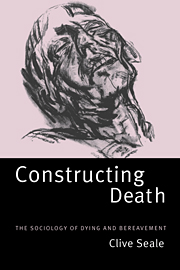9 - Grief and resurrective practices
Published online by Cambridge University Press: 28 October 2009
Summary
If we take seriously the view that human life involves continual inner activity to point the psyche in the direction of life, then the problem of grief cannot be confined to those who have recently experienced a major loss. The argument of the first part of this book suggested that security about being in the world (ontological security), initially generated in early childhood, is maintained in face-to-face interaction as the social bond is negotiated and affirmed. Conversation, taken as a social institution in which participants may draw upon a variety of available cultural scripts, serves as a micro-ritual for the sustenance and renewal of a secure narrative of self-identity. Anthropological work on narrative reconstruction by people with chronic illness, as well as analysis of the restorative effects of funeral laments on mourners, led to the view that talk could serve as the medium for a variety of resurrective practices. In the ebb and flow of everyday interaction, as has been conveyed so effectively in the work of Goffman, there exist numerous opportunities for small psychic losses, exclusions and humiliations, alternating with moments of repair and optimism. Scheff (1990) has sought to understand this quality of everyday interaction as consisting of cycles of shame and pride as the social bond is alternately damaged and repaired. The experience of loss and its repair is, then, a daily event. In this sense ‘bereavement’ (and recovery from it) describes the continual daily acknowledgement of the problem of human embodiment.
- Type
- Chapter
- Information
- Constructing DeathThe Sociology of Dying and Bereavement, pp. 193 - 211Publisher: Cambridge University PressPrint publication year: 1998

